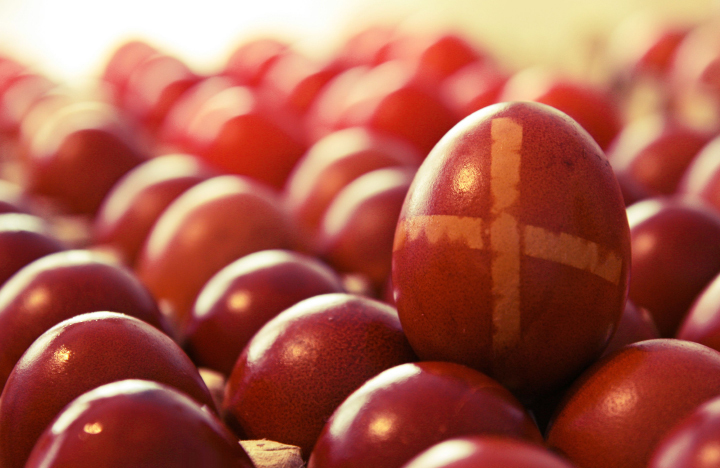Orthodox Easter is not just a religious observance; it's a cultural phenomenon that spans continents and embraces diverse traditions. Orthodox communities around the world come together to celebrate the resurrection of Christ in their own unique ways. Join us on a cultural odyssey as we explore the rich tapestry of Orthodox Easter traditions across the globe.
Albania: "Pashkët Ortodokse" - Orthodox Easter in Albania:
In Albania, where a significant portion of the population adheres to the Orthodox faith, Easter is known as "Pashkët Ortodokse" and is celebrated with great enthusiasm and devotion. The week leading up to Easter Sunday, known as Holy Week or "Java e Madhe," is filled with religious observances and traditional customs.
The week begins with Palm Sunday, known as "Dita e Palme" in Albanian. On this day, worshippers carry palm branches or olive branches to church to be blessed by the priest, symbolizing Jesus' triumphant entry into Jerusalem. The blessed branches are then taken home and placed above doorways or in the family's icon corner as a sign of protection.
Holy Thursday and Good Friday: Holy Thursday and Good Friday are days of fasting and solemn reflection. In many Albanian Orthodox churches, a special service called "Liturgy of the Twelve Gospels" is held on Thursday evening, recounting the events leading up to Christ's crucifixion. On Good Friday, known as "Dita e Shenjtë" or Holy Friday, worshippers participate in the veneration of the Epitaphios, a decorated cloth representing the burial shroud of Christ.
Easter Monday:Easter Monday, known as "Dita e Pashkëve" or Easter Day, is a time for family gatherings and feasting. Homes are filled with the aroma of traditional Albanian dishes, including roasted lamb, "qumështor" (a milk-based dessert), and "bukë e gjalpë" (bread and butter). Families visit relatives and friends, exchanging Easter greetings and well wishes for the new season of renewal and hope.
Russia:
In Russia, Orthodox Easter, known as "Paskha," is a grand affair steeped in centuries-old customs and rituals. The iconic onion-domed cathedrals of Moscow and St. Petersburg are adorned with colorful banners and illuminated by the glow of countless candles. The highlight of the Easter celebration is the midnight liturgy, where worshippers flock to churches to witness the Resurrection service. After the solemn observance, families gather for a festive meal featuring traditional dishes like kulich (sweet Easter bread) and paskha (a rich, creamy dessert). Red eggs, symbolizing the blood of Christ, are exchanged as tokens of goodwill and faith.
Greece:
In Greece, Orthodox Easter, or "Pascha," is a joyous celebration marked by a blend of religious solemnity and cultural revelry. The week leading up to Easter Sunday is filled with church services, including the poignant Good Friday procession, where mourners follow the epitaphios—a decorated bier representing the body of Christ. On Easter Saturday, the faithful gather outside churches to participate in the Resurrection service, lighting candles and proclaiming "Christos Anesti!" (Christ is risen!). The Easter feast is a lavish affair, featuring roasted lamb, tsoureki (sweet Easter bread), and a colorful array of dyed eggs. In some villages, the tradition of "tsougrisma" sees people playfully cracking eggs together, symbolizing the breaking of Christ's tomb.
Ethiopia:
In Ethiopia, Orthodox Easter, known as "Fasika," is celebrated with a unique blend of religious fervor and cultural heritage. The festivities begin with a 40-day period of fasting, during which believers abstain from meat, dairy, and other animal products. On Easter Eve, worshippers gather in churches for an all-night vigil, culminating in the Resurrection service at dawn. The highlight of the Easter feast is "doro wat," a spicy chicken stew served with injera (traditional flatbread). Pilgrims also flock to the holy city of Lalibela, home to awe-inspiring rock-hewn churches, to celebrate Easter in a truly spiritual setting.
Spain:
Semana Santa Processions: In Spain, Easter is celebrated with Semana Santa, or Holy Week, marked by solemn processions that wind through the streets of cities and towns. These processions feature elaborately decorated floats, or pasos, depicting scenes from the Passion of Christ. Hooded penitents, dressed in long robes, carry these pasos on their shoulders as they make their way through the streets, accompanied by mournful music and the rhythmic sound of drums. Semana Santa processions are a deeply moving expression of faith and a powerful reminder of the sacrifice of Christ
United States:
Easter Parades and Egg Hunts: In the United States, Easter is celebrated with a mix of religious observance and secular traditions. Easter Sunday often begins with sunrise services held outdoors, followed by Easter parades featuring elaborately decorated floats, marching bands, and participants in colorful costumes. Children eagerly participate in Easter egg hunts, searching for hidden eggs filled with candy and treats. The White House Easter Egg Roll, held annually on the lawn of the White House, is a time-honored tradition that dates back to 1878, bringing together families from across the country for a day of fun and festivities.
Orthodox Easter is a celebration that transcends borders, uniting believers around the world in a shared expression of faith and culture. Orthodox communities come together to commemorate the resurrection of Christ in ways that are as diverse as they are deeply rooted in tradition. Orthodox Easter is not just a religious holiday; it's a cultural odyssey that invites us to explore the richness and diversity of the human experience, bound together by the common threads of faith, heritage, and community.

Comments
Leave a comment